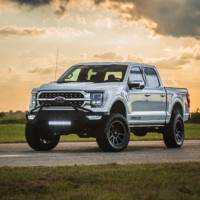From time to time we find out about a obscure UK manufacturer who develops very capable off-road cars.
The Fering Pioneer is the brainchild of ex Ferrari and McLaren engineer Ben Scott-Geddes, who has repurposed supercar and racing technology to provide environmental responsibility and unrivalled off-grid capabilities for the most extreme adventures.
Despite its imposing appearance, the Pioneer is no larger in any direction than a typical delivery van and is actually shorter than a Ford Mondeo Estate. It also weighs the same as a family hatchback.
Power to the axles is provided solely by two electric motors – unusual for an off-road vehicle. But they are perfectly suited to the task. They provide a total of 600Nm of torque; more than a comparable diesel 4×4.
A battery provides a zero local emission, electric-only range of around 50 miles. The Pioneer’s range extender generator is then available to give ability to keep going to the end of your adventure.
The Pioneer’s battery cells are not the same as you’d find in a conventional EV, as the usual Lithium-Ion chemistry is affected significantly by extremes of weather. Instead, Fering have used more sophisticated Lithium Titanate Oxide cells which are designed to survive extreme weather conditions.
For longer adventures, the battery is supported by an 800cc 3-cylinder range extender combustion engine powered by biodiesel. By operating consistently at its most efficient level, the engine generates power to run the motors and charge the battery in normal driving. This means the battery can cover peak demands for power – such as hill climbing – using energy reserves which are then replenished while the vehicle is cruising, stationary or braking.
Using advanced materials and techniques from the circuit and supercar has allowed the Pioneer to rewrite the rules on strength and lightness too. The dry kerb weight is around 1,500kg – the same as a medium-sized hatchback.
Despite this, the Pioneer is capable of carrying its own weight as a payload, with a 1,500kg capacity.
The combination of light weight and an efficient powertrain results in exceptional fuel economy. Even with the batteries discharged, the Pioneer is expected to deliver around 50mpg – half the consumption of other 4x4s, and comparable to a diesel hatchback.
The efficiency also means the Pioneer can have an incredible ability to live ‘off-grid’ and survive expeditions to remote areas without having to worry about refuelling. With long-range tanks fitted, the Fering will be capable of driving for 7,000km without needing a fuel stop or recharging from the grid. If such extreme range isn’t needed for the mission, the tanks can be swapped for water to provide fresh supplies on a mission.
Further examples of the ingenious thinking which has gone into making the Pioneer ‘extreme adventure ready’ include the choice of tyre. The 22.5-inch rims aren’t just bling which is designed for the boulevard – they accept standard size truck tyres to ensure easy availability in the remotest areas of the globe.
The Union Jack symbol moulded into the tailgate isn’t just to proudly signify the Fering’s British heritage either. The bars of the flag act as strengthening ribs to ensure rigidity in the panel.
The first prototype Pioneer is already going through a rigorous testing process and being assessed by early customers and organisations. Series production will start in the UK during the first half of 2022.



